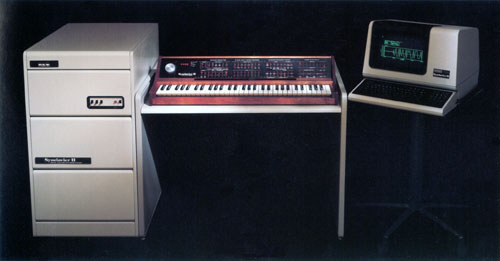 FRANK ZAPPA FANS HAVE waited a long time for this album. It was the last project Zappa worked on before his untimely death on December 4, 1993, and to be honest, I had entirely forgotten about it. Why the family trust waited for the best part of 22 years to get around to release what they purport to be his 100th album is hard to fathom; just as hard as it is to fathom why they chose this exact moment in time to do so.
FRANK ZAPPA FANS HAVE waited a long time for this album. It was the last project Zappa worked on before his untimely death on December 4, 1993, and to be honest, I had entirely forgotten about it. Why the family trust waited for the best part of 22 years to get around to release what they purport to be his 100th album is hard to fathom; just as hard as it is to fathom why they chose this exact moment in time to do so.
Perhaps it has something to do with the low profile Zappa has at the moment, despite Universal’s 2012 reissue of his catalogue in newly minted, remastered form; a campaign that was so desultory that it not only failed to find a new audience for the composer, but had the net effect of devaluing his brilliant work when many stores ended up selling their stock for stupidly low prices, and subsequently not bothering to carry Zappa titles at all. Perhaps the assumption is that the real Zappa fans will come out of the woodwork to support a serious “new” work, or even that Zappa’s stock as a serious composer keeps rising, and that the timing might even be right in certain lofty circles for an album of rather indigestible electronic work. Or hey, they may have just been cleaning up the storage facility, noticed the unloved recordings and thought: “why not?”
Whatever the reason – and really, it doesn’t matter – the release of Dance Me This is an exciting event for any hardcore Zappa fan. In the years since his death, there have been many releases from the vaults, but many have been unexpurgated live performances that were never meant for the public’s ears, and therefore, have lacked one of the things that made Zappa’s recorded output what is was: his special sequencing sauce, which was full of crazy contrasts and insane edits that would have been anathema to any DJ whose job it was to plaster over the cracks. But Zappa did explain back in ‘93 that Dance Me This was his attempt to create music for dance performances, not dance parties, so we knew it wasn’t going to be at all rock and roll.
To say that Dance Me This is atypical of the vast body of Zappa’s known work rather understates the matter, though. Entirely produced on a Synclavier (a now-redundant but then million-dollar-plus sampling computer mostly used by film soundtrack composers), it’s utterly absent of the very things that drew fans to his work in the first place: the ribald humour and scathing satire, the unrepentant (some would say verging on sacrilegious) merging of high and low culture, the tremendous eclecticism, and the ability to be more than one thing at one time – a plurality and complexity that keeps his records perpetually fresh and regenerating for the fans.
 There are other recordings where Zappa abandoned the multi-contextual barrage, including the albums dedicated to nothing so much as guitar soloing, and his orchestral projects, but Dance Me This takes the cake. Unlike even his other Synclavier recordings, most of the time melody and conventional timekeeping is all but eliminated in favor of an exploration of sound itself, which means that for all but followers of modern chamber works or the most academic electronic studies, it’s hard going.
There are other recordings where Zappa abandoned the multi-contextual barrage, including the albums dedicated to nothing so much as guitar soloing, and his orchestral projects, but Dance Me This takes the cake. Unlike even his other Synclavier recordings, most of the time melody and conventional timekeeping is all but eliminated in favor of an exploration of sound itself, which means that for all but followers of modern chamber works or the most academic electronic studies, it’s hard going.
Maybe that’s why it sat on the shelf for so long: while Zappa’s supposed masterwork Civilization Phase III (which combined Synclavier work with the precise real-time contributions of German classicists the Ensemble Modern) isn’t easy to get one’s head around, Dance Me This presents us with something like post-composition, a place where a dying man expunged most of what typified “Frank Zappa” to play around with note placements, infinitely fussy drum fills, and stereophonic SFX.
It’s tempting to draw conclusions based on the knowledge that this was Zappa’s last work, and as with parts of Civilization Phase III, parts of Dance Me This sound, if not unfinished, at least unresolved. Could it have been that the man who always railed against drugs had to spend the last few years of his life pumped up with them, and that this terribly ill man, woozy with strong painkillers, was influenced to make some uncharacteristic musical decisions? Could it be that this (mostly) overwhelmingly bleak music saw Zappa breaking from his usual considered satirical distance to transfer something of the bleakness of the void he was falling headfirst into?
This easy but obvious assumption is somewhat contradicted by the liner notes, which claim that the project is one that Zappa had been haltingly working on for many years, and that the last few working months of his life was a chance to gather the various strands of those strivings into one cohesive package. Still, the core of the album is the five-part, nearly 30 minutes of ‘Wolf Harbor’, a piece that, while reminiscent of parts of Civilization Phase III, had me thinking about the state of Zappa’s mind during its compositional gestation. Its relentless darkness had me imagining that this was Zappa’s way of casting himself to fate, and an indifferent universe.
Regardless of concerns about whether Zappa was capable at the end of properly finishing the job, and of my difficulties in comprehending it (or engaging with it the way I wish I could), Dance Me This manages something pretty amazing: to be a Zappa universe within Zappa’s universe. I can’t think of another record on the planet that works with this audible palette, or sounds anything like it.

Sure, there are those studious academic electronic projects that never break wind or crack a smile, and then there are those uneventful ambient projects that are so boring you might as well bring a sleeping bag. Then there are all the sub-genres of rhythm-based electronica from Richard D. James/Aphex Twin through to whatever they’re throwing up this week in the wake of dubstep. On Dance Me This, Zappa frequently uses drones and ambience, and exploits both to create an oppressive sense of tension, suspense and outright horror without ever sounding like some hack Hollywood film score merchant. Although there are moments of unusual emptiness here (unusual because Zappa traditionally fills every available space with busy goings-on), the composer adds a veritable arsenal of percussion instruments, but this virtual percussion orchestra is entirely of his making, and it’s strong on the kind of tonalities and juxtapositions he’s loved throughout his career, with everything from insect-like clicks to xylophones through to bells, gongs and the tympani all working together front of stage. And right to the end, it seems, Zappa enjoyed the way the Synclavier could time-stretch and mangle already ridiculous sounds, and there’s plenty of that here. Then when he’s inclined, Zappa adds certain symphonic instruments to the mix, making for a spectacular chamber disquietude. Particular favourites include a multiplicity of what I suspect to be lavatorial samples, as well as mutational burps, and vocals that are so mangled as to resemble that other noise-making apparatus between one’s bum cheeks.
And then there are the special guests. The story goes that Matt Groening (of The Simpsons fame) knew that Zappa loved Siberian music, and when some Tuvan throat singers were visiting LA, he invited them up to the Zappa residence, where sessions ensued. They can be seen in the BBC documentary on Zappa, and heard sparingly on Civilization Phase III; and now they’re draped all over Dance Me This. It’s tempting to accuse Zappa of cultural appropriation. I mean, what exactly was the intent here? Was he interested in the culture and meaning of the bizarre and haunting vocal style, or did he just see it as a cool effect to use on his final compositions? The important thing is that if the latter is true, it works.
As an album, despite the between-track segues, Dance Me This is curiously disembodied. It starts with the title track, which is like a tease for an album that never eventuates. It’s quite jolly, really – all 2 minutes and one second of it – and its piano melody could almost be a virtual mutation of one of Vince Guaraldi’s ragtime-influenced Peanuts themes. The Tuvans – Anatolii Kuular, Kaigl-ool Khovalyg and Kongar-ool Ondar – ululate over the top of a crisp drum figure, and Zappa teases us with the briefest of brief guitar solos, ever. That has to have been some kind of ironic comment on his audience’s incessant demand for more guitar, and this tiny wee solo is reputed to have been the last time the master picked up his instrument. As pleasant as it is, ‘Dance Me This’ really does come across like an intro, and ‘Pachuco Gavotte’, only slightly longer at 3:27, also plays out like an intro. A variation on the famous redundant piano triplets that Zappa loved/hated so much is performed while a flotilla of toy instruments threaten to lose control of their limbs. There are characteristic percussion flourishes and bathroom noises (puking? toilet flushing?)
It’s really the monstrous ‘Wolf Harbor’ that makes the album. I would stumble along trying to describe it, but that endeavour would take about as long as listening to it, and be far less pleasurable. Suffice to say that its bells and salty dissonance give it a nautical flavour that has me imagining rotting old boats in fog-shrouded harbours, and then scoping down into the murky depths where who knows what horrors lurk. By the second section of these conjoined quintuplets, things have gotten seriously percussion-centric, with everything from the simple intricacies of tabla through to the dynamic violence of big drums proving that there’s a whole world to find in mismatched things to bang on. The third section starts out with smeared vocal Doppler effects, bubbling SFX, chimes/xylophones, Christmas bells and those infamous Zappa “snorks”; all of them part of the Zappa lexicon, but not within such a seemingly tuneless, avant garde context in which the point seems to be the sounds themselves, how they are organised and contextualized together, and the way they spring around the stereo spectrum. If there’s one word I could use to describe ‘Wolf Harbor’, it’s “ghostly”, and the one strong influence that comes through in both the dissonance and the percussion play is Zappa’s own hero, Varese. It’s a striking work – one that I think should have been the last half of the record, because everything that comes later inevitably pales in comparison.
‘Goat Polo’ brings back the Tuvans, and features busy percussion, and a sense of urgency, with a sense that something really bad is going to happen. Blasts of deep orchestrations are layered on to reinforce the ominous tones of the Tuvan singers. But then, a lighter mood is broached with some string keyboard figures harking back to Zappa’s original all-Synclavier Grammy winner, Jazz From Hell. The effect is kind of like hearing a happy polka from a bar mitzvah leaking into a funeral home during a somber memorial service.
 ‘Rykoniki’ is a snappy little thing at only 1:59, with a sequential melody against, um… more ominous chords, while ‘Piano’ is effectively the last piece, and its seven minutes and nine seconds work as a kind of tribute to the fantastical, impossible virtual ‘player’ piano of Conlon Nancarrow.
‘Rykoniki’ is a snappy little thing at only 1:59, with a sequential melody against, um… more ominous chords, while ‘Piano’ is effectively the last piece, and its seven minutes and nine seconds work as a kind of tribute to the fantastical, impossible virtual ‘player’ piano of Conlon Nancarrow.
‘Calculus’ (at a mere 2:49), as explained in the liner notes, is barely even a Zappa track, but its awkward, lumbering groove does at least provide a little end-of-game levity. Apparently, Zappa’s studio assistant Todd Yvega prepared an ‘automatic groove’ under Tuvan singing, while Zappa was sleeping, and designed to be replaced later on. Zappa wanted it kept, saying: “By that point in the album, after all the preceding escapades, some relief by way of mindless foom-fop is exactly what we need.”
So there we have it, one of the least accessible or commercially minded albums in the Zappa catalogue is also his last, which seems appropriate. I don’t think it will go on the critical registrar as one of his greatest works, but there’s real greatness to be found in these pieces, for those of us unencumbered by the need for melodies and choruses and guitar solos and songs about dancing fools.
It’s not perfect, but it is a work made by a dying genius, so it’s not going to be shit, is it? GARY STEEL
Music = 4/5
Sound = 4.5/5
[Note: Gary Steel reserves the right to reappraise and alter his star ratings up or down at any time].















Thanks, I hope it sounds like you describe.
Frank talked about the project with Guitarist magazine a few months before his death…http://frankzapppa.blogspot.com/2015/07/discography-dance-me-this.html